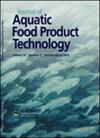高效薄层色谱法测定罗非鱼中的生物胺
IF 1.3
4区 农林科学
Q4 FOOD SCIENCE & TECHNOLOGY
引用次数: 2
摘要
摘要采用简单、廉价、可靠的HPTLC方法,对罗非鱼(Oreochromis niloticus)肉中6种生物胺(组胺、腐胺、尸胺、酪胺、精胺和亚精胺)在+4°C和+30°C温度下的监测。对于50、100和200 mg kg−1这三种测试浓度,该方法的性能参数在25–300 mg kg−l范围内线性良好(R2≥0.984),精密度(RSD≤16%),真实性和准确度(-20%至+10%范围)。罗非鱼由于含有腐胺和尸胺,在环境储存条件下的保质期限制在18小时。本文章由计算机程序翻译,如有差异,请以英文原文为准。
Monitoring of Biogenic Amines in Tilapia Flesh (Oreochromis niloticus) by a Simple and Rapid High-Performance Thin-Layer Chromatography Method
ABSTRACT The monitoring of six biogenic amines (histamine, putrescine, cadaverine, tyramine, spermine, and spermidine) in tilapia (Oreochromis niloticus) flesh held at +4°C and +30°C was accomplished using a straightforward, inexpensive, and trustworthy HPTLC approach. For the three tested concentrations of 50, 100, and 200 mg kg−1, the performance parameters of the method were good in terms of linearity within the range of 25–300 mg kg−1 (R2 ≥ 0.984), precision (RSD ≤ 16%), trueness and accuracy (-20% to +10% range). The shelf life of tilapia was restricted to 18 hours under ambient storage conditions due to its putrescine and cadaverine contents.
求助全文
通过发布文献求助,成功后即可免费获取论文全文。
去求助
来源期刊
CiteScore
3.50
自引率
6.20%
发文量
77
审稿时长
7 months
期刊介绍:
The Journal of Aquatic Food Product Technology publishes research papers, short communications, and review articles concerning the application of science and technology and biotechnology to all aspects of research, innovation, production, and distribution of food products originating from the marine and freshwater bodies of the world. The journal features articles on various aspects of basic and applied science in topics related to:
-harvesting and handling practices-
processing with traditional and new technologies-
refrigeration and freezing-
packaging and storage-
safety and traceability-
byproduct utilization-
consumer attitudes toward aquatic food.
The Journal also covers basic studies of aquatic products as related to food chemistry, microbiology, and engineering, such as all flora and fauna from aquatic environs, including seaweeds and underutilized species used directly for human consumption or alternative uses. Special features in the journal include guest editorials by specialists in their fields and book reviews covering a wide range of topics.

 求助内容:
求助内容: 应助结果提醒方式:
应助结果提醒方式:


